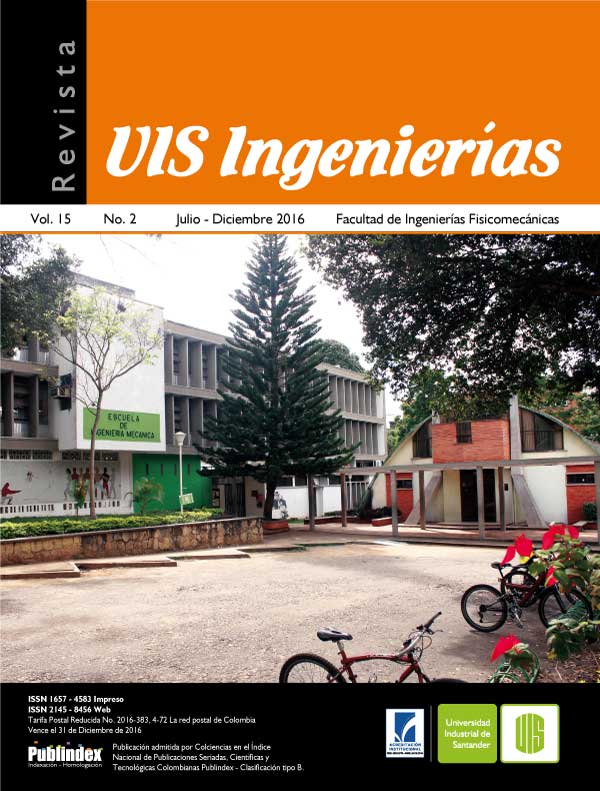Articles
Structural integrity analysis of composite pipes for thetransport of crude oil by finite elements
Published 2016-06-28
Keywords
- Composite pipes,
- finite element analysis,
- simulation,
- failure criteria,
- ASTM D2290
How to Cite
González-Estrada, O. A., Leal, J., & Reyes-Herrera, J. D. (2016). Structural integrity analysis of composite pipes for thetransport of crude oil by finite elements. Revista UIS Ingenierías, 15(2), 105–116. https://doi.org/10.18273/revuin.v15n2-2016009
Abstract
In this work, we performed a finite element analysis (FEA) to characterize the mechanical behavior of the composite pipe Fiberspar in order to investigate the structural integrity of composite pipes for crude oil transport in Colombia.Tests according to ASTM D2290 standard were performed in the laboratory to determine the tensile ultimate strength and compare the results with the numerical model.Failure criteria Tsai-Wu and Tsai-Hill were considered for the pipes working at different pressures, including operational pressure and, thus, the failure values and critical layers were identified.
Downloads
Download data is not yet available.
References
- R. Rafiee, “On the mechanical performance of glass-fibre-reinforced thermosetting-resin pipes : A review,” Compos. Struct., vol. 143, pp. 151–164, 2016.
- N. Ji, H. Geun, and J. Heum, “Structural analysis and optimum design of GRP pipes based on properties of materials,” Constr. Build. Mater., vol. 38, pp. 316–326, 2013.
- D. Hull, “Research on composite materials at Liverpool University. I. Failure of filament wound tubes,” Phys. Technol., vol. 13, no. 5, 1982.
- J. R. M. de Sousa, G. B. Ellwanger, and E. C. P. Lima, “Modelo tridimensional de elementos finitos para el análisis de esfuerzos de tubos flexibles,” Boletín Técnico, vol. 42, no. 2, pp. 1–20.
- X. Anping, S. Peng, Z. Jingjing, and Q. Yunxia, “FEA-based Comparison of Two Kinds of Steel Wire Reinforced Composite Pipes,” 4th Int. Conf. Intell. Networks Intell. Syst., pp. 184–187, 2011.
- K. Yu, E. V. Morozov, M. A. Ashraf, and K. Shankar, “Analysis of flexural behaviour of reinforced thermoplastic pipes considering material nonlinearity,” Compos. Struct., vol. 119, pp. 385–393, 2014.
- K. Yu, E. V. Morozov, M. a. Ashraf, and K. Shankar, “Numerical analysis of the mechanical behaviour of reinforced thermoplastic pipes under combined external pressure and bending,” Compos. Struct., vol. 131, pp. 453–461, 2015.
- L. A. Quintero Ortiz, J. R. Arciniegas Villamizar, M. C. Jiménez Romero, and A. Y. Vallen Vargas, “Efecto en las propiedades mecánicas de daños superficiales generados en tubería compuesta flexible para transporte de hidrocarburos.,” Rev. Ing., no. 42, pp. 39–48, 2015.
- Y. Bai, J. Tang, W. Xu, Y. Cao, and R. Wang, “Collapse of reinforced thermoplastic pipe (RTP) under combined external pressure and bending moment,” Ocean Eng., vol. 94, pp. 10–18, 2015.
- Y. Reutov, “The Calculation of Multilayer Polymer Pipes Using Finite Elements and their Application to Gas and Oil Pipelines,” pp. 3–5, 2013.
- J. L. C. G. De Kanter and J. Leijten, “Thermoplastic Composite Pipe : Analysis and Testing of a Novel Pipe System for Oil & Gas.”
- H. Bakaiyan, H. Hosseini, and E. Ameri, “Analysis of multi-layered filament-wound composite pipes under combined internal pressure and thermomechanical loading with thermal variations,” Compos. Struct., vol. 88, no. 4, pp. 532–541, 2009.
- M. Xia, “Bending behavior of filament-wound fiber-reinforced sandwich pipes,” vol. 56, pp. 201–210, 2002.
- P. D. Soden, M. J. Hinton, and A. S. Kaddour, “Biaxial test results for strength and deformation of a range of E-glass and carbon fibre reinforced composite laminates. Failure exercise benchmark data,” Fail. Criteria Fibre-Reinforced-Polymer Compos., vol. 62, pp. 52–96, 2004.
- P. A. Quigley, S. C. Nolet, and J. G. Williams, “Composite spoolable tube,” 2001.
- C. Kaynak, E. S. Erdiller, L. Parnas, and F. Senel, “Use of split-disk tests for the process parameters of filament wound epoxy composite tubes,” Polym. Test., vol. 24, no. 5, pp. 648–655, 2005.
- M. Carroll, F. Ellyin, D. Kujawski, and A. S. Chiu, “The rate-dependent behaviour of ± 55 ° filament-wound glass-fibre/epoxy tubes under biaxial loading,” Compos. Sci. Technol., vol. 55, no. 95, pp. 391–403, 1995.
- A. Majid and M. S. Bin, “Behaviour of composite pipes under multi-axial stress,” Newcastle University, 2011.
- E. J. Barbero, Finite Element Analysis of Composite Materials Using ANSYS, Second. Boca Raton, U.S.A.: CRC Press, 2013.
- L. Arias Maya and L. Vanegas Useche, “Falla de los materiales compuestos laminados,” Sci. Tech., no. 25, pp. 113–118, 2004.
- M. E. Tuttle, Structural Analysis of Polymeric Composite Materials. New York, U.S.A., 2004.
- M. Molinier, “Análisis de los criterios de falla aplicados a los laminados compuestos,” Universidad de Buenos Aires, 2005.
- АSTM Standard, “ASTM 2290-12 Standard Test Method for Apparent Hoop Tensile Strength of Plastic or Reinforced,” ASTM B. Stand., pp. 1–8, 2016.
- Fiberspar, “Full Reel Program. Certified Installer Training,” 2010.

